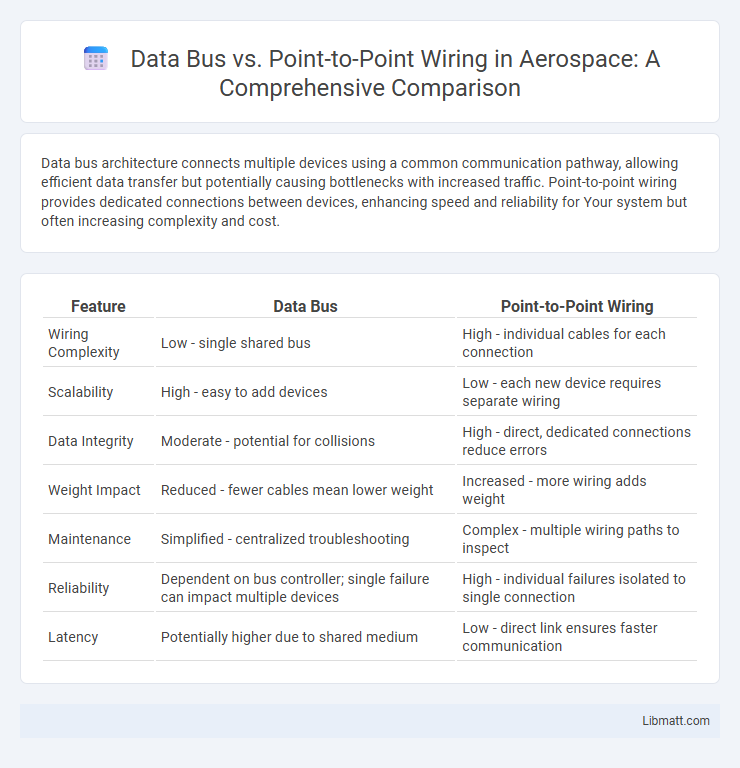Data bus architecture connects multiple devices using a common communication pathway, allowing efficient data transfer but potentially causing bottlenecks with increased traffic. Point-to-point wiring provides dedicated connections between devices, enhancing speed and reliability for Your system but often increasing complexity and cost.
Table of Comparison
| Feature | Data Bus | Point-to-Point Wiring |
|---|---|---|
| Wiring Complexity | Low - single shared bus | High - individual cables for each connection |
| Scalability | High - easy to add devices | Low - each new device requires separate wiring |
| Data Integrity | Moderate - potential for collisions | High - direct, dedicated connections reduce errors |
| Weight Impact | Reduced - fewer cables mean lower weight | Increased - more wiring adds weight |
| Maintenance | Simplified - centralized troubleshooting | Complex - multiple wiring paths to inspect |
| Reliability | Dependent on bus controller; single failure can impact multiple devices | High - individual failures isolated to single connection |
| Latency | Potentially higher due to shared medium | Low - direct link ensures faster communication |
Introduction to Data Bus and Point-to-Point Wiring
Data bus systems utilize a shared communication pathway where multiple devices transmit and receive data over the same set of wires, enabling efficient data exchange and simplified wiring architecture. Point-to-point wiring establishes a direct, dedicated connection between two devices, enhancing signal integrity and reducing interference but increasing the complexity and amount of wiring required. Understanding the structural differences between data bus and point-to-point wiring is crucial for optimizing network design and achieving desired performance in electronic systems.
Fundamental Concepts and Definitions
A data bus is a communication system that transfers data between components using a shared set of parallel or serial lines, allowing multiple devices to connect and transmit data through common pathways. Point-to-point wiring involves direct connections between two specific devices, enabling dedicated communication without interference from other components. Data buses are typically used for efficiency and scalability in systems with many devices, while point-to-point wiring ensures higher speed and reliability through isolated, dedicated channels.
Architecture of Data Bus Systems
Data bus systems feature a shared communication pathway where multiple devices connect to a single set of signals, allowing efficient data transfer but limited bandwidth due to bus contention. The architecture uses a common bus line with address, data, and control signals, enabling multiple components to communicate sequentially over the same channel. This contrasts with point-to-point wiring, where each pair of devices has dedicated connections, providing higher bandwidth and reduced latency but increased complexity and wiring requirements.
Point-to-Point Wiring: Structure and Layout
Point-to-point wiring features direct electrical connections between components, using dedicated wires that link each pair of devices without shared pathways. This structure enhances signal integrity and reduces interference by minimizing crosstalk common in bus configurations. The layout requires careful planning to manage physical routing complexity and ensure reliable communication across multiple links.
Key Differences Between Data Bus and Point-to-Point
Data bus architecture allows multiple devices to share a common communication line, improving efficiency and reducing wiring complexity compared to point-to-point wiring. Point-to-point connections establish dedicated, direct links between two devices, ensuring higher data transfer speed and reduced signal interference but at the cost of increased cabling and limited scalability. Key differences include data bus supporting multi-device communication through a shared medium, while point-to-point wiring prioritizes direct device-to-device connections for enhanced reliability and performance.
Scalability and System Expansion
Data bus architecture offers limited scalability due to shared communication lines, causing potential bandwidth bottlenecks as more devices are added to the system. Point-to-point wiring enables easier system expansion by providing dedicated connections between components, ensuring consistent performance and minimal signal interference. Your choice impacts future growth, with point-to-point wiring better suited for complex systems requiring high scalability and reliable data transfer.
Signal Integrity and Reliability
Point-to-point wiring enhances signal integrity by minimizing crosstalk and electromagnetic interference through dedicated transmission paths, ensuring consistent data transfer and reducing errors. Data bus architectures, while cost-effective and simpler to implement, are more susceptible to signal degradation caused by multiple nodes sharing the same communication line, leading to potential reliability issues. Maintaining high signal integrity and overall system reliability is critical in applications requiring precise data communication, favoring point-to-point wiring in such contexts.
Cost and Complexity Comparison
Data bus wiring reduces material costs and simplifies installation by allowing multiple devices to share a single communication line. Point-to-point wiring increases expenses and complexity due to dedicated cables for each connection, requiring more wiring infrastructure and higher labor effort. The cost-efficiency of data bus systems makes them preferable for large networks, while point-to-point wiring offers better performance at a higher cost suitable for critical connections.
Typical Applications and Use Cases
Data bus wiring is typically used in applications requiring multiple devices to communicate over a shared medium, such as in industrial automation, automotive networks like CAN bus, and computer memory modules. Point-to-point wiring is favored in scenarios demanding high-speed, low-latency communication and dedicated connections, including high-performance computing, telecommunication backbones, and certain PCI Express architectures. Choosing between data bus and point-to-point wiring depends on factors like scalability, signal integrity, and network complexity in specific use cases.
Choosing the Right Wiring Method for Your Project
Choosing the right wiring method for your project depends on factors like signal integrity, scalability, and complexity. Data bus wiring efficiently handles multiple device communication but may suffer from signal degradation and limited speed over long distances. Point-to-point wiring offers superior performance and reliability for high-speed data transfer by providing dedicated connections, making it ideal for projects requiring minimal interference and maximum data integrity.
data bus vs point-to-point wiring Infographic

 libmatt.com
libmatt.com